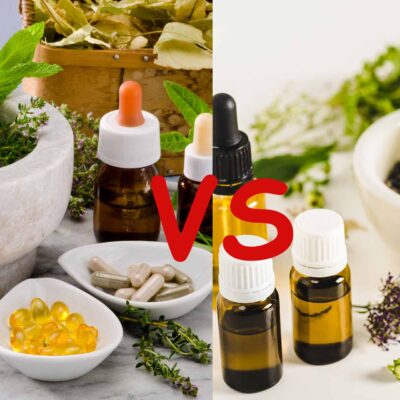Disclaimer: The information on this website is not intended to be a substitute for professional medical advice, diagnosis, or treatment. Essential oils are powerful substances and should be used with caution. Always consult with a qualified healthcare professional before using any essential oils.
Essential Items of a Homeopathic Medicine Cabinet: A Beginner’s Guide to Holistic Remedies
For those seeking natural remedies, homeopathic medicine offers a holistic approach to healing. If you are new to this field, you may be wondering what homeopathy is all about and how it works. This beginner’s guide will provide you with the essential pantry items for a homeopathic medicine cabinet, so you can start your journey towards holistic remedies.
What is homeopathy and how does it work?
Homeopathy is a system of alternative medicine that believes in the principle of “like cures like.” It is based on the idea that a substance that causes symptoms in a healthy person can be used to treat similar symptoms in a sick person. Homeopathic remedies are highly diluted substances that stimulate the body’s natural healing abilities.
The key concept of homeopathy is individualization. Each person is treated as a unique individual, and remedies are chosen based on their specific symptoms and overall constitution. Homeopathic remedies can be in the form of pellets, tablets, or liquid solutions.
Benefits of using holistic remedies
There are several benefits to using holistic remedies like homeopathy:
- Natural and safe: Homeopathic remedies are made from natural substances and are considered safe with no known side effects.
- Whole-body approach: Holistic remedies aim to treat the root cause of the illness rather than just alleviating symptoms. They focus on restoring balance and promoting overall well-being.
- Personalized treatment: Homeopathy takes into account the individual’s unique symptoms and constitution, providing personalized treatment plans.
- No drug interactions: Homeopathic remedies do not interact with conventional medications, making them suitable for use alongside other treatments.
By stocking your homeopathic medicine cabinet with essential pantry items like Arnica, Chamomilla, and Nux Vomica, you will have a good foundation for treating common ailments and promoting natural healing.
Remember, homeopathy is a complementary approach, and it is always advisable to consult with a qualified homeopath or healthcare professional before starting any new treatment.
The Essentials
Arnica Montana
Arnica Montana is a popular homeopathic remedy that has been used for centuries to treat various ailments. Derived from the Arnica plant, this natural remedy is known for its anti-inflammatory and pain-relieving properties.
Arnica Montana is a perennial herb that is native to Europe and Siberia. It is also commonly known as mountain tobacco or leopard’s bane. The plant produces yellow flowers that are harvested and used to create the homeopathic remedy.
In homeopathy, Arnica Montana is primarily used to treat bruises, sprains, and muscle soreness. It is believed to help reduce inflammation, promote healing, and relieve pain. This remedy is available in various forms, including tablets, creams, gels, and ointments.
Arnica Montana has a wide range of uses and benefits in homeopathic medicine. Some of the key uses include:
- Treating bruises: Arnica Montana is commonly used to reduce bruising and swelling caused by injuries or surgery.
- Relieving muscle soreness: This remedy can help alleviate muscle pain and stiffness caused by overexertion or strenuous exercise.
- Healing wounds: Arnica Montana may promote wound healing by reducing inflammation and stimulating blood flow to the affected area.
- Easing arthritis pain: Some individuals find relief from arthritis symptoms, such as joint pain and stiffness, by using Arnica Montana.
It’s important to note that while Arnica Montana has been widely used in homeopathic medicine, it’s always recommended to consult with a qualified healthcare professional before starting any new treatment regimen.
Overall, Arnica Montana is a valuable addition to any homeopathic medicine cabinet due to its versatile uses and potential benefits in promoting holistic healing.
2. Nux Vomica
Nux Vomica is a homeopathic remedy derived from the seeds of the Strychnos nux-vomica tree. It has been used for centuries in traditional medicine to treat various ailments. In homeopathy, Nux Vomica is primarily known for its ability to alleviate digestive issues and symptoms associated with overindulgence.
Nux Vomica is widely used in homeopathic medicine for its therapeutic properties. Here are some common uses and benefits:
- Relief from digestive disorders: Nux Vomica is often recommended for individuals experiencing indigestion, bloating, constipation, or heartburn. It helps to regulate the digestive system and promote healthy digestion.
- Treatment of hangovers: Due to its detoxifying properties, Nux Vomica can be helpful in alleviating the symptoms of a hangover, such as headache, nausea, and sensitivity to light and sound.
- Management of stress and anxiety: Nux Vomica is known for its calming effects on the nervous system. It can help reduce stress, irritability, and insomnia caused by mental or emotional strain.
- Relief from menstrual symptoms: Women experiencing menstrual cramps, irregular periods, or other discomforts may find relief with Nux Vomica. It can help regulate hormonal imbalances and alleviate associated symptoms.
- Treatment of respiratory conditions: Nux Vomica may be used to relieve symptoms of respiratory conditions like coughs, colds, and sinusitis. It helps to soothe inflammation and support the body’s natural healing process.
It is important to note that Nux Vomica should be used under the guidance of a qualified homeopathic practitioner. They can determine the appropriate dosage and frequency based on individual symptoms and overall health.
Belladonna
Belladonna, also known as deadly nightshade, is a highly poisonous plant that has been used in homeopathic medicine for centuries. Despite its toxic nature, when prepared in a diluted form, it can be a powerful remedy for various ailments.
In homeopathy, Belladonna is primarily used to treat acute conditions characterized by sudden onset and intense symptoms. It is commonly prescribed for fever, inflammation, headaches, and infections. The key principle behind its use is “like cures like,” meaning that a substance that can cause symptoms in a healthy person can also be used to treat similar symptoms in a sick person.
Belladonna has a wide range of applications in homeopathic medicine. Some of its common uses include:
- Fever: Belladonna is often prescribed for high fevers accompanied by hot skin, flushed face, and dilated pupils. It helps to reduce the intensity and duration of the fever.
- Inflammation: Belladonna is effective in relieving inflammation, especially in conditions such as sore throat, tonsillitis, and ear infections.
- Headaches: This remedy is known to alleviate headaches characterized by throbbing pain, especially those that worsen with motion or light.
- Infections: Belladonna can be used to treat various infections, such as urinary tract infections, sinusitis, and skin abscesses.
It is important to note that while Belladonna can be beneficial when used appropriately and under the guidance of a qualified homeopathic practitioner, self-medication should be avoided. Consulting with a professional will ensure the correct dosage and potency for your specific condition.
Overall, Belladonna is a valuable addition to any homeopathic medicine cabinet, providing natural and holistic remedies for a range of acute conditions.
Apis Mellifica
Apis Mellifica is a homeopathic remedy derived from the honeybee. It is commonly used to treat various health conditions and is known for its anti-inflammatory and pain-relieving properties. This remedy is prepared by diluting the venom of the honeybee and potentizing it to create a safe and effective medicine.
Apis Mellifica is goof for:
1. Insect bites and stings: Apis Mellifica is often used to relieve the symptoms of insect bites and stings, such as swelling, redness, and itching. It can help reduce the pain and inflammation associated with these reactions.
2. Allergic reactions: This remedy is also beneficial in treating allergic reactions, especially those that involve swelling of the skin or mucous membranes. It can help alleviate symptoms like hives, itching, and burning sensations.
3. Urinary tract infections: Apis Mellifica is commonly prescribed for urinary tract infections characterized by burning or stinging pain during urination. It can help reduce inflammation in the urinary tract and relieve discomfort.
4. Eye conditions: Homeopathic practitioners often recommend Apis Mellifica for eye conditions such as conjunctivitis or pink eye. It can help reduce redness, swelling, and burning sensations in the eyes.
5. Inflammatory conditions: This remedy is also used to treat various inflammatory conditions, including arthritis, bursitis, and edema. It can help reduce swelling, stiffness, and pain associated with these conditions.
It is important to consult with a qualified homeopathic practitioner before using Apis Mellifica or any other homeopathic remedy. They can provide personalized guidance based on your specific symptoms and health history.
Chamomilla
For those interested in exploring holistic remedies, building a homeopathic medicine cabinet is a great way to promote natural healing. One essential item to include in your cabinet is Chamomilla, a versatile herb that has been used for centuries in homeopathic medicine.
Chamomilla, also known as German chamomile, is a flowering plant that belongs to the daisy family. It is native to Europe and has a long history of medicinal use. The plant’s flowers are dried and used to make teas, tinctures, and homeopathic remedies.
Chamomilla is known for its calming and soothing properties. It is commonly used to treat conditions such as anxiety, insomnia, and digestive issues. In homeopathic medicine, Chamomilla is often recommended for teething babies who are irritable and restless.
Some of the key benefits of Chamomilla include:
- Promotes relaxation: Chamomilla can help calm the nervous system, making it useful for relieving stress and anxiety.
- Aids digestion: This herb has been traditionally used to alleviate digestive discomfort, including indigestion, bloating, and stomach cramps.
- Relieves teething pain: Chamomilla is a popular remedy for soothing teething babies who experience irritability and pain.
Including Chamomilla in your homeopathic medicine cabinet ensures that you have a natural remedy on hand for various common ailments. However, it’s important to consult with a qualified homeopath or healthcare professional before using any herbal remedies, especially if you have underlying health conditions or are taking medications.
Remember, building a holistic medicine cabinet is just the first step towards embracing natural healing. It is always recommended to seek professional advice for personalized treatment plans and guidance on using homeopathic remedies safely and effectively.
Ignatia Amara
Ignatia Amara, also known as St. Ignatius bean, is a homeopathic remedy derived from the seeds of the Strychnos ignatii tree. It is primarily used to address emotional and psychological symptoms, making it a valuable addition to any holistic medicine cabinet.
Ignatia Amara is commonly used to treat grief, loss, and emotional distress. It is particularly effective in cases where individuals experience intense sadness, mood swings, or difficulty in coping with emotional upheavals. Some specific uses and benefits of Ignatia Amara include:
- Grief and Loss: Ignatia Amara can be helpful in alleviating the symptoms associated with grief and loss, such as sadness, crying spells, and melancholy.
- Emotional Upheavals: It is also beneficial for individuals who experience sudden mood swings, irritability, or emotional sensitivity due to stress or emotional trauma.
- Headaches: Ignatia Amara can provide relief from headaches that are triggered by emotional stress or suppressed emotions.
- Sleep Disorders: This homeopathic remedy can help improve sleep quality in individuals who have difficulty falling asleep or experience restless sleep due to emotional distress.
- Anxiety and Depression: Ignatia Amara may be used as part of a holistic treatment plan for anxiety and mild depression, especially when symptoms are related to emotional stressors.
It’s important to note that while Ignatia Amara can be beneficial for these conditions, it is always recommended to consult with a qualified homeopathic practitioner for personalized advice and dosage instructions.
Remember, building a holistic medicine cabinet is a journey, and it’s essential to educate oneself about the proper use and potential interactions of each remedy.
Aconitum Napellus
Aconitum Napellus, commonly known as monkshood or wolfsbane, is a perennial herbaceous plant that belongs to the buttercup family. It is native to mountainous regions of Europe and Asia. In homeopathic medicine, Aconitum Napellus is derived from the roots and leaves of this plant.
Aconitum Napellus has been used for centuries in homeopathic medicine for its various therapeutic properties. Here are some of its common uses and benefits:
- Fever and Inflammation: Aconitum Napellus is often used to treat sudden fevers and inflammatory conditions. It can help reduce fever, relieve pain, and alleviate symptoms associated with colds, flu, and other acute illnesses.
- Anxiety and Panic: This homeopathic remedy is also known for its calming effects on the nervous system. It can be used to alleviate anxiety, restlessness, and panic attacks.
- Sleep Disorders: Aconitum Napellus is sometimes prescribed for individuals who struggle with insomnia or have difficulty falling asleep due to anxiety or restlessness.
- Respiratory Conditions: It is commonly used to treat respiratory conditions such as coughs, bronchitis, and asthma. Aconitum Napellus can help relieve coughing, reduce inflammation in the airways, and promote easier breathing.
- Pain Relief: This homeopathic remedy is also known for its analgesic properties. It can be used to alleviate various types of pain, including headaches, toothaches, and neuralgia.
It is important to consult a qualified homeopathic practitioner before using Aconitum Napellus or any other homeopathic remedy. They can provide personalized guidance and dosage recommendations based on your specific needs and health condition.
Building your own homeopathic medicine cabinet is a great way to have natural remedies readily available for common ailments. By stocking up on essential pantry items, you can take a step towards a more holistic approach to healthcare.
Building your own homeopathic medicine cabinet
- Arnica: This remedy is great for relieving pain, reducing inflammation, and promoting healing of bruises and muscle strains.
- Chamomilla: Chamomilla is commonly used for teething pain in infants, as well as soothing digestive issues and calming nerves.
- Aconite: Aconite is often used at the onset of cold or flu symptoms, helping to reduce fever, alleviate anxiety, and relieve sore throat.
- Apis Mellifica: This remedy is useful for treating insect bites and stings, as well as relieving swelling and itching.
- Nux Vomica: Nux Vomica is beneficial for digestive issues such as indigestion, heartburn, and constipation.
Important considerations and tips for using holistic remedies
- Consult a professional: It’s important to consult with a qualified homeopath or healthcare provider before using any holistic remedies, especially if you have underlying health conditions or are taking medications.
- Follow dosage instructions: Always follow the recommended dosage instructions for each remedy to ensure safe and effective use.
- Store remedies properly: Keep your homeopathic remedies in a cool, dry place away from direct sunlight to maintain their potency.
- Keep a record: It can be helpful to keep a record of the remedies you have used and their effectiveness for future reference.
Remember, homeopathic remedies are not a substitute for professional medical care. If you have severe or persistent symptoms, it’s important to seek medical attention.
Archives
Calendar
| S | M | T | W | T | F | S |
|---|---|---|---|---|---|---|
| 1 | 2 | 3 | 4 | 5 | ||
| 6 | 7 | 8 | 9 | 10 | 11 | 12 |
| 13 | 14 | 15 | 16 | 17 | 18 | 19 |
| 20 | 21 | 22 | 23 | 24 | 25 | 26 |
| 27 | 28 | 29 | 30 | 31 | ||











